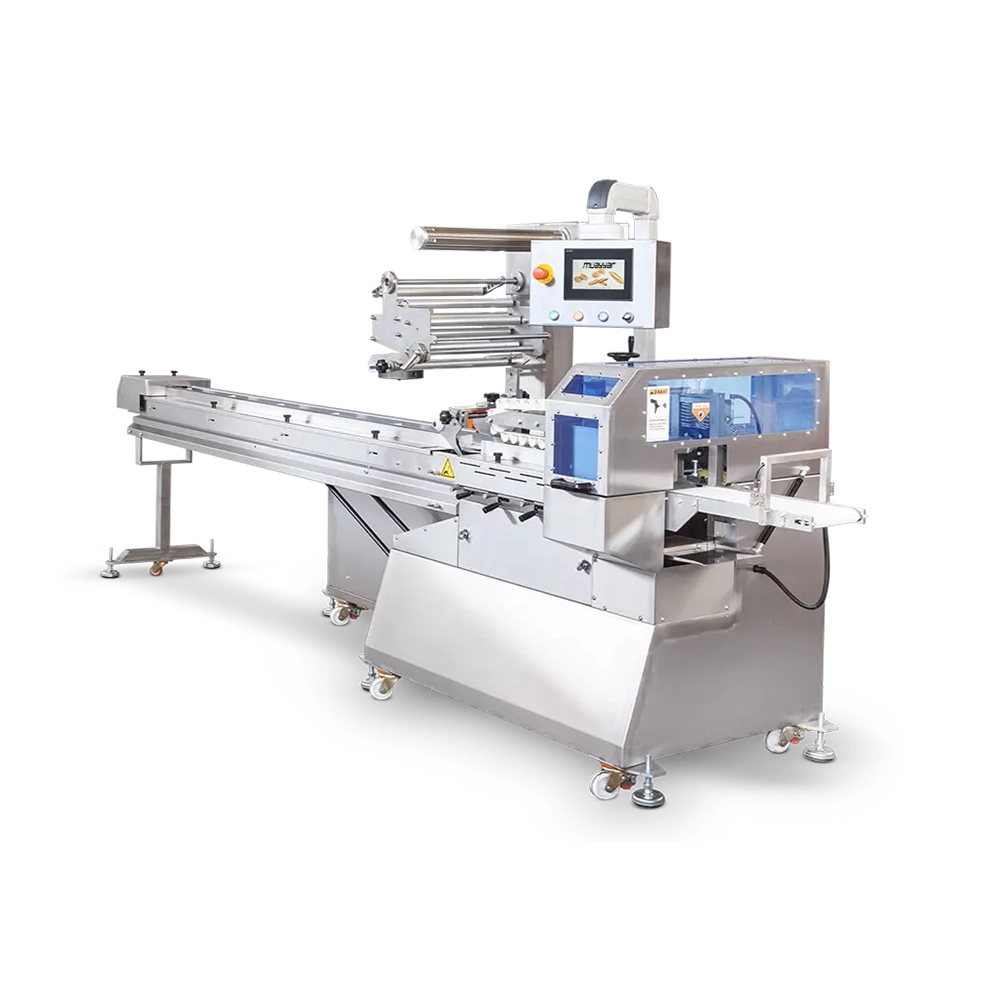| Control | PLC Control |
| Touch Screen Size (inch) | 7” |
| Chassis | Stainless steel |
| Length (mm) | 3940 |
| Wide (mm) | 900 |
| high (mm) | 1820 |
| Voltage | 380 V 50-60 Hertz 3 Phase |
| Total Power (kw) | 2.2 |
| Digital Temperature Display Sensitivity | + – 2 Degrees |
| Packaged Dimensions | 7x23x14 |
| Fault Indicator | Yes |
| Speed Control | Yes |
| Required Air | 6 Bars |
| Weight | 700 Kg |
Bread Packaging Machine For Hamburger , Sandwich and Toast
1. Double frequency converter control, the bag length can be set and cut, no need to adjust the air, one step in place, saving time and film.
2. Man-machine interface, parameter setting is convenient and quick.
3. Fault self-diagnosis function, the fault display is clear at a glance.
4. High-sensitivity photoelectric eye color tracking, digital input sealing and cutting position, making the sealing and cutting position more accurate.
5. Temperature independent PID control, better suited to a variety of packaging materials.
6. Reciprocating end seal mechanism, the seal is more firm, and the seal cutter has no loss.
7. End sealing angling device, the bag shape is more beautiful, and the product grade is improved. 8. Positioning stop function, no sticking knife, no waste film.
9. The transmission system is simple, the work is more reliable, and the maintenance is more convenient.
10. All control is realized by software, which is convenient for function adjustment and technical upgrade, and never lags behind.
Detailed Information About Bread Packaging Machines:
In the fast-paced world of food production, efficiency and quality are paramount. For the bakery industry, where bread is a staple, packaging plays a crucial role in preserving freshness, ensuring hygiene, and attracting consumers. The advent of bread packaging machines has revolutionized this process, offering advanced solutions to meet the demands of modern bakeries.
Evolution of Bread Packaging Machines:
Historically, bread packaging was a manual process involving labor-intensive tasks such as slicing, wrapping, and sealing. However, with technological advancements, automated bread packaging machines have emerged, streamlining production while maintaining product integrity.
Early bread packaging machines were basic, primarily focusing on wrapping and sealing loaves. Over time, these machines evolved to incorporate features such as slicing, portioning, labeling, and even inserting promotional materials or coupons into packages.
Key Features and Components:
Modern bread packaging machines boast an array of features designed to optimize efficiency and quality. These machines typically consist of the following components:
Feeding System: Automated systems for transporting bread loaves into the packaging unit.
Slicing Mechanism: Precision slicing to ensure uniformity and consistency in loaf size.
Wrapping Unit: Utilizes various materials such as plastic film or paper to securely wrap the bread.
Sealing Mechanism: Heat-sealing or adhesive methods to seal the package.
Labeling System: Integration of labels with product information, expiry dates, and barcodes.
Quality Control Sensors: Optical sensors to detect defects or foreign objects in bread loaves.
User Interface: Intuitive controls for operators to monitor and adjust machine settings.
Types of Bread Packaging Machines:
Bread packaging machines come in various types to accommodate different bakery sizes and production volumes:
Automatic Bread Packaging Lines: Fully automated systems capable of handling large-scale production, from slicing to packaging, with minimal human intervention.
Semi-Automatic Bread Packaging Machines: Suited for medium-sized bakeries, these machines require some manual input but offer significant automation for wrapping and sealing.
Tabletop Bread Packaging Equipment: Compact machines ideal for small bakeries or specialty bread producers, offering basic packaging functionalities.
Benefits of Bread Packaging Machines:
The adoption of bread packaging machines brings numerous benefits to bakery operations:
Increased Efficiency: Automation reduces manual labor and production time, enabling higher output and cost savings.
Improved Product Quality: Consistent slicing and packaging ensure uniformity and freshness, enhancing the overall quality of bread products.
Enhanced Hygiene: Sealed packaging protects bread from contaminants, maintaining hygiene standards and extending shelf life.
Options: Advanced machines allow for customizable packaging designs and branding, enhancing product visibility and consumer appeal. Regulatory Compliance: Integrated labeling systems ensure compliance with food safety regulations and traceability requirements. Challenges and Considerations: While bread packaging machines offer numerous advantages, there are some challenges and considerations to address: Initial Investment: The cost of purchasing and installing advanced packaging equipment can be significant, particularly for smaller bakeries. Maintenance Requirements: Regular maintenance and servicing are essential to ensure optimal performance and longevity of the machines. Staff Training: Operators require training to operate and maintain the machinery effectively, minimizing downtime and errors. Adaptability: Bakery operations may require machines capable of handling various bread sizes, shapes, and packaging formats, necessitating adaptable equipment. Conclusion: Bread packaging machines represent a technological leap in the bakery industry, offering efficient, hygienic, and customizable solutions for packaging bread products. From automated slicing to precision wrapping and labeling, these machines streamline production while maintaining product quality and integrity. While initial investment and operational considerations exist, the long-term benefits justify the adoption of these advanced systems, ensuring bakeries remain competitive in the evolving market landscape.


Reviews
There are no reviews yet.